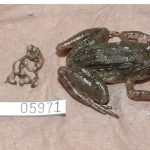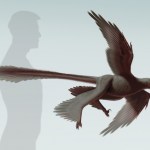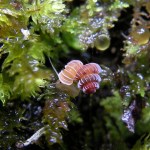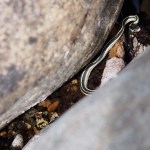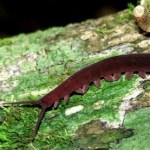species
Image of big eared bats By Stihler Craig, U.S. Fish and Wildlife Service [Public domain], via Wikimedia Commons
According to a press release from Northern Arizona University, Drs. Faith Walker and Carol Chambers at the Bat Ecology & Genetics Lab have developed a system called Species From Feces to identify bat species from guano collected in field locations such as mines, caves, bridges, etc. The system takes advantage of DNA sequencing technology and an assay to look for genetic identifiers unique to different species using DNA barcodes. The sequences can then be…
Check out the tiny new species of frogs discovered in the cloud forests of Brazil.
Brachycephalus mariaeterezae
Brachycephalus fuscolineatus
Brachycephalus verrucosus
Brachycephalus leopardus
Brachycephalus boticario
Brachycephalus olivaceus
Images from LiveScience.
Male (left) and female L. Larvaepartus frogs discovered in Sulawesi, Indonesia. Image from Figure 2 of PLOS ONE article.
A new species of frog (Limnonectes larvaepartus) has been discovered in the rain forest of Sulawesi island in Indonesia. This species challenges the grade-school wisdom that taught us: 'frogs lay eggs'. It looks like textbooks will need to be revised as this is the only known exception to that rule. Study author Dr. Jimmy McGuire (University of California, Berkeley) said the following as quoted in Reuters, "Reproduction in most frogs could not be more…
This newly discovered feathered dinosaur, Changyuraptor yangi, was built like a modern airplane. Illustration by S. ABRAMOWICZ, DINOSAUR INSTITUTE, NHM.
Photo of fossil by: Luis Chiappe Dinosaur Institute, NHM as published in the USA Today
The discovery of this non-avian dinosaur, Changyuraptor yangi, that lived 125 million years ago suggests that flight came before birds. The fossil was discovered in the Liaoning Province of northeastern China by Luis Chiappe from the Natural History Museum in Los Angeles, CA. At nearly 4 feet long, it is the largest so-…
Photo Credit: Liew Thor-Seng
Ten new species of snails in the genus Plectostoma have been discovered in the limestone hills of Southeast Asia. Limestone hills are not common in this region, so the individual snail species are often isolated to just one hill. Therefore mining has threatened their existence and several species are already extinct or endangered.
Source:
LiveScience
I came across this neat "name that animal" quiz. How well do you know your animals? Find out now!!
Click here to take the quiz!
I found this beautiful snake basking in barely flowing water at an elevation of about 5800' in the Sierra Nevada mountains of California. At first I thought it was a striped racer, but racers have two light stripes on their sides, while this one has a light stripe down the middle of its back and a light underbelly. It appears to be a juvenile garter snake, or at this altitude, it could be full-grown, morphologically adapted to a less plentiful food web. It's rather small, about 24" long. Click any image below for full size.
Light belly, dark back with a single stripe down the middle…
Image of velvet worm from: Oliveira et al / Zoologischer Anzeiger
A new species of velvet worm (Eoperipatus totoros) is the first to be described from Vietnam after its discovery in 2010. This 2.5 inch long worm is distinguished from other velvet worms by hairs with unique shapes that cover its body. These animals are difficult to find and study because they are usually hiding in the moist soil to prevent dehydration. However, during the rainy season, they exit the soil and can be spotted. What is neat about these worms is that they hunt by spraying a glue-like…
Meet the first newly discovered mammalian species in 35 years, the olinguito, as presented by Rob Nelson from Untamed Science:
Adult male lesula monkey discovered in the Democratic Republic of Congo. Image: M. Emetshu. PLOS One, doi:10.1371/journal.pone.0044271.g007.
Dr. John Hart, Scientific Director of the Lukuru Wildlife Research Foundation in Kinshasa, discovered the colorful lesula monkey while sifting through photos brought back from a 2007 field expedition to the Democratic Republic of Congo. Shown in the photo was a little girl named Georgette feeding one. The monkeys have blond manes and upper chests with a bright red patch on their lower backs. After extensive…
Strumigenys rogeri in the leaf litter
In 1982, a small journal called The Coleopterists Bulletin carried a two page note by beetle expert Terry Erwin that increased- by an order of magnitude- the estimated number of species on the planet. Erwin crunched some back-of-the-napkin numbers based on the tree specificity of arthropods he'd collected in Panamanian tree canopies and the richness of tropical tree species worldwide to surmise that the earth should hold 30 million species. An impressive bump from the 1 to 2 million that was the going estimate.
Later research on canopy arthropods (For…
Walk through the rainforests of Ecuador and you might encounter a beautiful butterfly called Heliconius cydno. It's extremely varied in its colours. Even among one subspecies, H.cydno alithea, you can find individuals with white wingbands and those with yellow. Despite their different hues, they are still the same species... but probably not for much longer.
Even though the two forms are genetically similar and live in the same area, Nicola Chamberlain from Harvard University has found that one of them - the yellow version - has developed a preference for mating with butterflies of its own…
tags: lories, Loriinae, Loriidae, ornithology, molecular biology, natural history museums
A young pair of Meyer's Lories (Lorikeets), Trichoglossus flavoviridis meyeri.
Image: Iggino [larger view].
"Can you help us identify a mystery lory in our collection?"
I was pleasantly surprised to find this email request from Donna Dittmann, Collections Manager and Museum Preparator for the Section of Genetic Resources at Louisiana State University Museum of Natural Science in Baton Rouge, Louisiana.
"Sure," I wrote back. "Send it to me and I'll see what I can do."
I, and some of my lories,…
This is the second of eight posts on evolutionary research to celebrate Darwin's bicentennial.
What do you get when one species splits into separate lineages? Two species? Think bigger...
When new species arise, they can set off evolutionary chain reactions that cause even more new species to spring forth - fresh buds on the tree of life create conditions that encourage more budding on different branches.
Biologists have long suspected that these "cascades of speciation" exist but have struggled to test them. Enter Andrew Forbes from the University of Notre Dame - his team of has…
Humans have been blamed for the disappearance of species before but never quite like this. Scientists at the University of Oxford have found evidence that two species of bacteria are merging into one. The two species are swapping genetic material at such a high rate that they are on the road to sharing a single, common genome. Their genetic merger is probably the result of being thrust into a new environment - the intestines of heavily farmed chickens, cattle and other domesticated livestock.
The two bacteria in question - Campylobacter jejuni and Campylobacter coli - are two of the most…
This is some very basic biology: when resources are unlimited and there are no pressures on a species, its population grows exponentially. There's also no evolution other than random mutations; without selection pressures (regardless of whether it's natural or artificial), the genetic information content of a species doesn't change appreciably.
Biologists make use of this to perform tests on certain cells. If you simply put a population of cells in a petrie dish and left them there, they start out by doing this:
They divide. They take over the dish. But then, they run out of room. And when…
tags: researchblogging.org, evolution, bird-dinosaur split, dinosaurs, birds, rocks-versus-clocks, fossil record, molecular clocks
The first feathered dinosaur fossil found in China -- Sinosauropteryx.
The feathers can be seen in the dark line running along the specimen's back.
Image: Mick Ellison, AMNH [larger view]
There is a lot of controversy among scientists regarding when modern birds first appeared. The current fossil record suggests that modern birds appeared approximately 60-65 million years ago when the other lineages of dinosaurs (along with at least half of all terrestrial…
